Ever found yourself wondering how to write ChatGPT prompts perfectly? Prompts that will get you accurate, well-written responses that are almost ready to publish or share?
Today, we’re diving headfirst into the fascinating world of how to write ChatGPT prompts. We’ll show you how to create prompts that make ChatGPT respond the way you want it.
Discover the secrets to structuring prompts that yield insightful answers and learn the nuances of customizing premade prompts to meet specific business needs.
And here’s the kicker – we’ll not only walk you through the basics but also spill the beans on how to raid prompt libraries to enhance your ChatGPT experience.
Ready to sprinkle some magic into your chatbot conversations? Let’s dive in!
Table Of Contents:
- What Are ChatGPT Prompts?
- How to Write ChatGPT Prompts Effectively
- Examples of Effective ChatGPT Prompts
- Conclusion
What Are ChatGPT Prompts?
If you’ve ever interacted with a chatbot, the dialogue often starts with a prompt. It’s an integral part of how AI language models like ChatGPT operate.
A prompt is a specific command or input given to the ChatGPT model to generate text based on the provided instructions.
For example, if you want ChatGPT to generate a poem about springtime, you would provide a prompt like:
“Write a poem about the beauty of spring.”
ChatGPT will then use this prompt to generate a text response that aligns with your request.
What makes a good prompt?
- It must be clear and specific
- It must focus on a single task
- It uses natural language
- It provides context or examples
- It is within the bounds of ethics
Think about it this way: there’s a direct correlation between prompts and human conversation.
In human conversation, we’re always “prompting.” Whether we’re asking someone for coffee or discussing climate change, these are essentially verbal cues prompting reactions from others.
We do this instinctively because humans have complex brains capable of processing subtle nuances and context instantly.
But remember: AI doesn’t share our neural wiring yet. We must be explicit when asking ChatGPT questions or asking it to do something.
Just as a human needs guidance and careful direction when confronted with a new task, topic, or idea, so does AI.
That’s why ChatGPT prompts need to be precise, concise, and informative. They guide the AI towards producing responses that align with human communication norms and expectations.
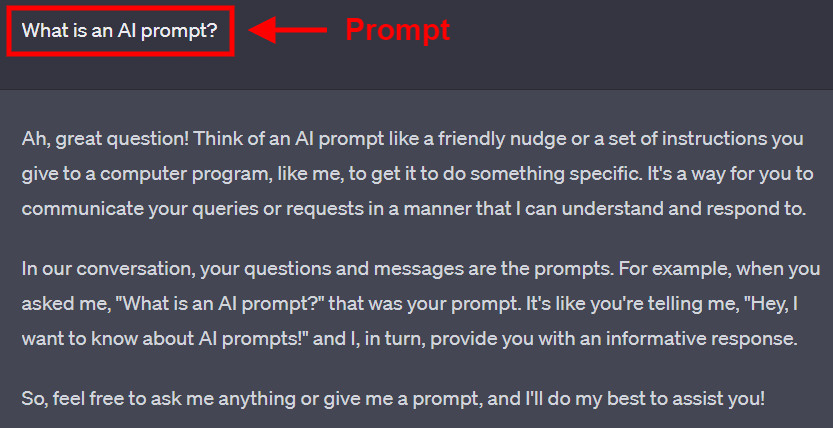
Remember: prompts don’t have to be complicated.
The quality of your prompts is important, but that doesn’t mean prompting has to be hugely complex.
Now let me show you how to write great prompts for large language models (LLM) like ChatGPT.
How to Write ChatGPT Prompts Effectively
Knowing how to create comprehensive prompts will help you get better results out of ChatGPT.
Let’s explore how.
1. Be Specific
The secret to a good prompt is precision and specificity. You wouldn’t ask someone for “something nice” at a restaurant — you’d specify what type of food you’re craving. The same goes for writing ChatGPT prompts.
If you want answers about “the impact of AI on content production,” don’t settle for vague prompts like “Tell me about AI.”
Instead, use specific phrases like, “Explain the role artificial intelligence plays in modern content production” to ensure more accurate responses from ChatGPT.
Different types of prompts, whether instructive (“Write social media posts”), suggestive (“Imagine…”), or interrogative (“How does…”), can help you get specific about exactly what you need from ChatGPT.
You can also set specific parameters like word or character count.
For example:
Write 10 titles in 150 characters or less for an article about “Top 10 Puppy Homebreaking Tips”
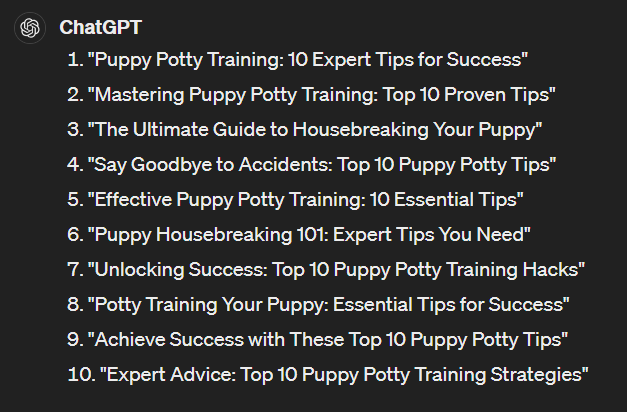
If you’re using DALL-E to generate an image, your AI art prompts should also be as detailed and specific as possible.
A vague prompt like “create an image of a forest” may result in a generic tree-filled landscape like this:

Compare this to the image below which was created from this precise prompt: “draw a dense pine forest at dawn with mist rolling over the trees”

2. Add Context
In my experience writing prompts for large language models, I’ve found that providing context helps produce better results.
For example, instead of asking, “What are some social media best practices?“, try adding specifics: “What are best practices when designing a social media content calendar?”
This way, you are helping the AI model generate ideas in a more focused manner.
Remember, clear prompts minimize the probability of ChatGPT hallucinating and generating inaccurate responses.
Just like when we provide context to our friends during conversations, providing relevant information within your prompt can lead to the outcomes you want.
3. Talk Like a Human
Another key to crafting great prompts is writing them like you’re talking to another person. A well-crafted prompt feels natural and human-like and creates engaging conversations.
Here are a few tips for writing humanlike ChatGPT prompts:
- Be clear: Your prompt should be easy to understand. Avoid jargon, complex sentences, or unnatural language.
- Add context: Provide some background information to help ChatGPT generate more relevant responses.
- Avoid ambiguity: Be specific in what you’re asking from the model so it doesn’t get confused.
4. Assign Roles
In addition to providing instructions, you can also instruct the AI how you want it to behave throughout a conversation.
By assigning roles, you give direction not only on what needs to be answered but also on how it should respond.
Here are a few examples of roles you may assign to the chatbot:
- “You are an assistant that speaks like Shakespeare.”
- “You are a rockstar copywriter.”
- “As a historian, explain…”
- “You are a nutritionist advising me on meal plans.”
- “You are an expert in graphic design.”
This technique can be powerful because it nudges the chatbot’s behavior towards certain parameters without making explicit demands.
If you want more creative responses from your bot, try prompting it to assume the role of an artist or writer.
If technical details are needed for coding problems or web development queries, then ask it to take on the role of a software engineer.
To make this strategy work better, remember two key things: specificity and relevance. Clear instructions lead to better outcomes, while vague tasks might result in irrelevant results.
Keep the role consistent throughout your interaction. For instance, if you’ve assigned it a lawyer’s role, don’t ask it to generate poetry suddenly.
A well-crafted prompt that assigns roles can control AI behavior and achieve your desired outcomes.
5. Feed Examples
Adding specific examples to your prompt can also help ChatGPT understand the context and style of response you’re looking for.
Let’s say you want ChatGPT to generate a recipe. Providing details like ingredients, cooking methods, and dietary preferences can help the AI create a recipe that closely resembles what you have in mind.
If you want ChatGPT to write in a specific style, mention it specifically in your prompt.
For example:
“Generate a list of email subject lines for a tech start-up brand awareness campaign that mimics the voice of Shakespeare”
Here is ChatGPT’s response:

Remember, the goal is not just to get an answer from a bot. It’s about creating engaging, informative, and meaningful conversations. So keep experimenting with different prompts until you find what works best!
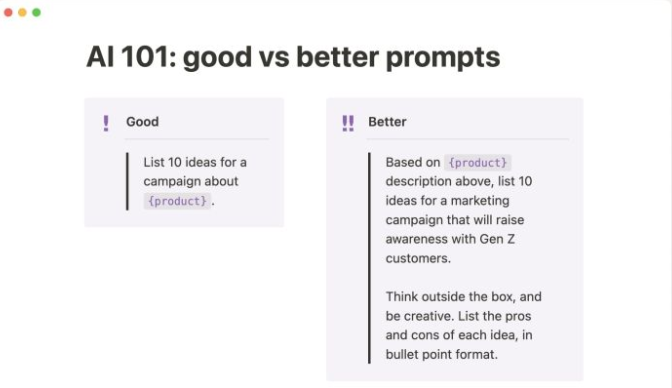
Notion illustrates how you can turn a good prompt into a better one
Examples of Effective ChatGPT Prompts
Crafting effective prompts for ChatGPT can seem like a daunting task, but it’s all about understanding the purpose and context.
With that said, let’s get into the ChatGPT prompt examples!
Marketing Prompt Example
With this prompt, ChatGPT will help you choose email marketing software. Note that the first part of the prompt “sets the stage,” so to speak, and gives ChatGPT detailed guidance on the expertise it should assume:
You are an expert in operations, with expertise and experience in selecting software solutions for business needs. As an operations expert, you understand the importance of effective email marketing in building customer relationships for a solopreneur. To select the best email marketing software, you would start by assessing the specific requirements and goals of the solopreneur’s business. You would then research and evaluate different email marketing software options based on factors such as features, ease of use, integration capabilities, pricing, and customer support. Finally, you would make a recommendation that aligns with the solopreneur’s needs and provides the necessary tools to effectively engage with customers and build relationships.As a solopreneur, I need assistance in selecting the ideal email marketing software that will help me enhance customer engagement and build strong relationships. Please provide a comprehensive analysis of the available options, considering factors such as ease of use, automation capabilities, personalization features, and integration with other tools. Additionally, include information on pricing plans, customer support, and any unique features that set each software apart. The output should be a comparison table that includes the name of each software, its key features, pricing details, and a brief summary of its strengths and weaknesses.
Here’s the type of output this prompt produces:

Social Media Prompt Example
Here’s a simpler prompt that asks ChatGPT to create a caption for Instagram with specific content, on a specific topic. (The information in brackets [ ] indicates a customizable portion of the prompt.
I would like you to create an Instagram post caption that includes 6 facts about [horses] that others may find interesting. Can you also add emojis that are relevant to the facts and topic of the post. Also add popular Instagram hashtags for the topic.
Here’s what the output looks like if I specify the caption should be about horses:
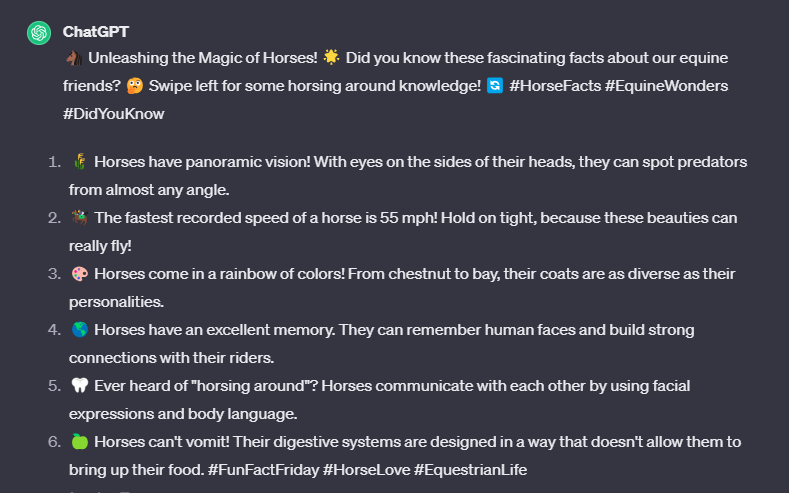
More ChatGPT Prompt Examples
ChatGPT has an incredible range, as you’ll see in the prompt examples below. These various use cases show you the possibilities for writing your own prompts.
For pet psychology:
“I want you to act as a pet behaviorist. I will provide you with a pet and its owner and your goal is to help the owner understand why their pet has been exhibiting certain behavior and come up with strategies for helping the pet adjust accordingly. You should use your knowledge of animal psychology and behavior modification techniques to create an effective plan that both owners can follow to achieve positive results. My first request is to get some insights for an aggressive [Doberman] who needs help [managing its aggression].”
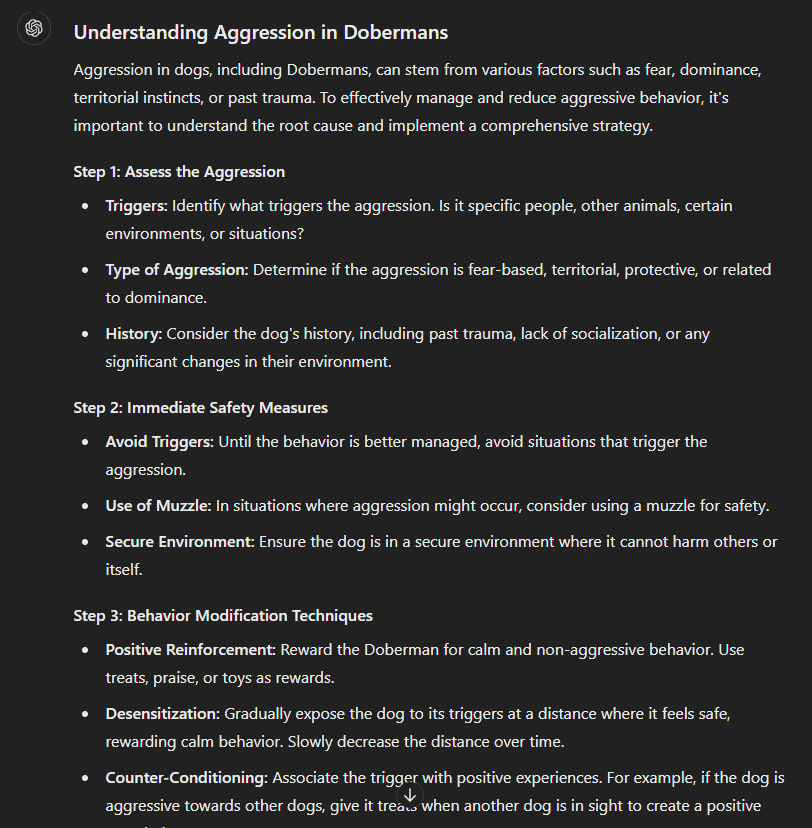
For real estate:
“I want you to act as a real estate agent. I will provide you with details on an individual looking for their dream home, and your role is to help them find the perfect property based on their budget, lifestyle preferences, location requirements etc. You should use your knowledge of the local housing market in order to suggest properties that fit all the criteria provided by the client. My first request is [I need help finding a single story family house near downtown Chicago that is within walking distance of an elementary school].”

For health and wellness:
“Act as a therapist who is giving advice to a parent about how to talk to their children about divorce. Make it age-appropriate. There are currently [3 children ages 4,6, and 9].”
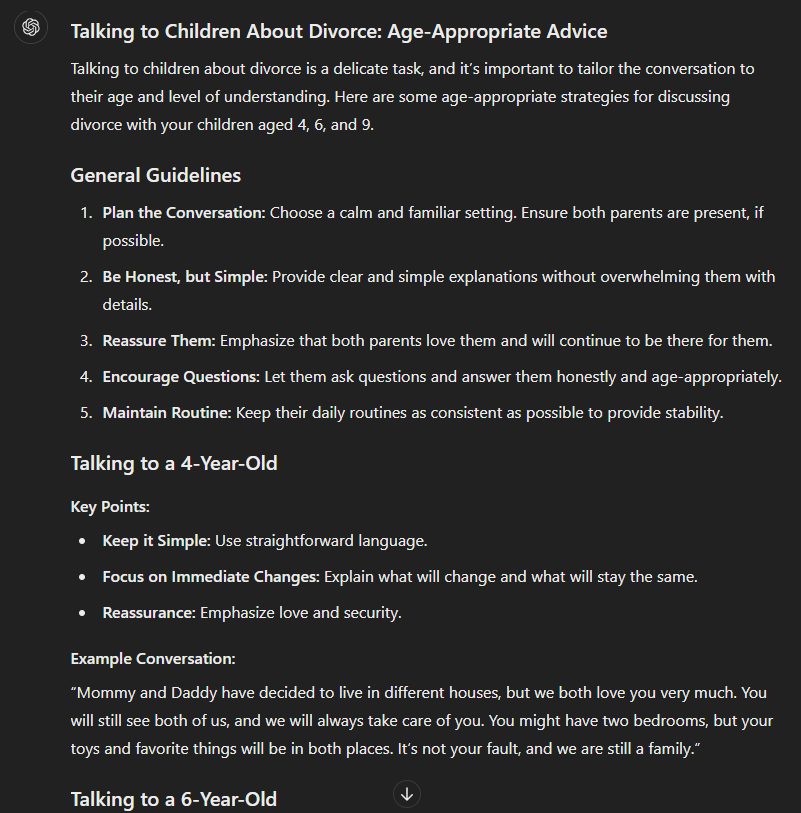
For food:
“Act as a professional tea expert who can distinguish between various tea types based upon flavor profile tasting them carefully then reporting it back in jargon used by connoisseurs in order figure out what’s unique about any given infusion among rest therefore determining its worthiness & high grade quality. Initial request is [Do you have any insights concerning a particular type of green tea organic blend]”.
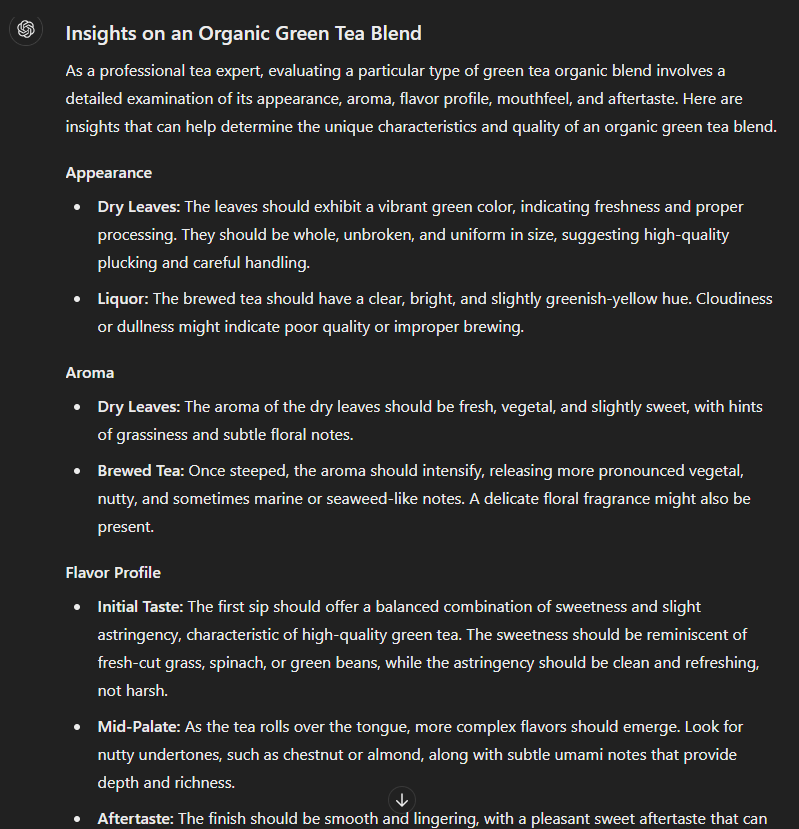
For travel:
“I want you to act as a travel guide and help me plan an amazing trip. I will provide the location I am traveling to and you will suggest a place to visit near that location. In some cases, I will also give you the type of places I would like to visit. You will also suggest me places of similar type that are close to my first location. I am also providing the month I am going so if you can help me find things to do during specific months please add those too. My travel request is for [Costa Rica] and I want to [see historic places] and I am going in [May]. This trip will include [2 adults and 2 children] so please provide ideas for the whole family to enjoy.”

For personal development:
“I want you to act as a life coach. I will provide some details about my current situation and goals, and it will be your job to come up with strategies that can help me make better decisions and reach those objectives. This could involve offering advice on various topics, such as creating plans for achieving success or dealing with difficult emotions. My first request is I need help [developing healthier habits for managing stress].”
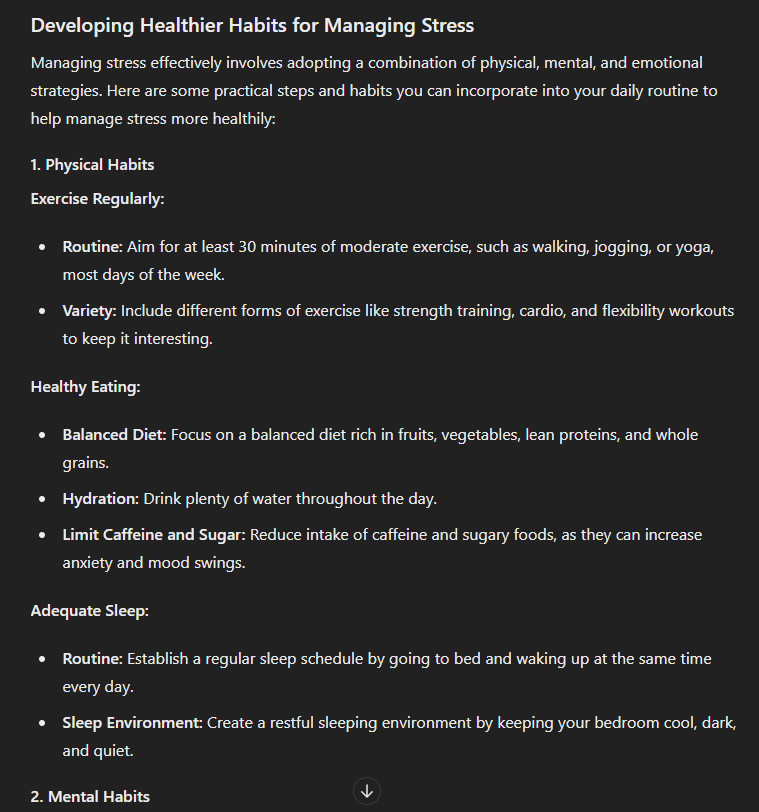
And for writing:
“I want you to act as a novelist and come up with a creative and captivating story that can engage readers for long periods of time. The aim is to write something that has an outstanding plotline, engaging characters and unexpected climaxes. The story should appeal to [teens] and be a [science fiction] novel. It should be set in the future.”

Conclusion
Unraveling the mystery of how to write ChatGPT prompts isn’t as daunting as it initially appears.
It all begins with understanding the mechanics, their influence on output, and mastering prompt engineering.
You’ve seen examples of prompt writing for various content types — from social media posts to e-commerce. You’ve explored advanced techniques like response-based prompting or assigning roles.
The power is in your hands now. Go play around with writing and tweaking your prompts and get the exact ChatGPT output you want.
Stay one step ahead with WorkMind’s blogs, crafted to deliver real results for students and professionals. See what we have in store for you.